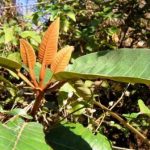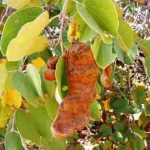TREE LIFE
AUGUST 2001
THE RED FACE ON YOUR LABEL IS A REMINDER THAT YOUR SUBS ($200) ARE OUTSTANDING AND IF NOT RECEIVED THIS MONTH YOU WILL SADLY COME OFF THE MAILING LIST.
MASHONALAND CALENDAR
Saturday 4 August Botanic Garden Walk – meet in the car park of the Botanic Garden at 10.45 for 11 am. where we will meet Tom.
Sunday 19 August. This is a new venue for us in the Mutepatepa farming area. The Nicolle family – John & Yoland and Lance & Colleen, will be our hosts at Selwood Farm. The planned walking place is good Brachystegia woodland interspersed with a large selection of other species.
Saturday 25 August Mark’s next walk will be at Mr. David Hatendi’s property near Harare where we will meet at 2.30 pm. Take the Enterprise Road, 8.5 kms from the traffic lights at the Chisipite shops turn left into the Hatendi property signposted Charmwood. There will be a Tree Soc. Sign.
Tuesday 4th September Back to summer Botanic Garden walks again.
MATABELELAND CALENDAR
Sunday 5th August. A meeting has been organized by Clem Van Vliet to Mabukawene Aloe Garden in Burnside,.
Please meet at Mabukawene at 9.30 am and for confirmation or additional details contact Jonathan Timberlake.
MATABELELAND BRANCH FUTURE
Given the rather uncertain and economically difficult times we are going through, and the fuel crisis, perhaps it isn’t surprising that attendance at many of the Matabeleland Branch outings has been low. It has been increasingly difficult to organize monthly trips and get a worthwhile turnout. This has been compounded by the departure of our Chairman – Anthon Ellert – to the United States for the next few years, with no one willing to take over the position.
The Branch held its AGM on 24 May, the main point of discussion being the Branch’s future. The six people present decided not to “mothball” the Branch, but to keep it alive at a lower level of activity. We received an offer from the Matobo Conservation Society to “caretake” us in the interim, such that all Tree Society members can participate in all the well-attended and well-organized MCS outings. These take place about every 3 months, and are generally in the broad Matobo area – an area of great beauty and diversity that doesn’t involve great expenditure in fuel. The Branch will ensure, as far as practicable, that announcements of forthcoming meets come out in “Tree Life” in good time. The Tree Society could also have a small section to mention anything of interest in the quarterly MCS newsletter, if the Branch wishes.
In addition, the AGM decided that the Branch should continue to have occasional, but not monthly, meets whenever a suitable opportunity arises or someone is willing to organize it. These may be local, i.e. within Bulawayo to keep up tree identification skills, or further afield including weekend trips. As before, there will be joint meets to more distant places with the Harare Tree Society. There are also possibilities of occasionally joining forces with the Bulawayo Bird Club to suitable venues. Again, every effort will be made to advise members in good time through “Tree Life”.
At present there is no Chairman of the Branch (any offers?). Jonathan Timberlake is still Secretary and will maintain the Branch files and continue liaison with Harare his telephone numbers are 09-286529 or 285761 (tel/fax) or email <timber@telconet.co.zw>.
Hopefully these arrangements will allow the Branch to continue, albeit meeting less regularly. Please contact Jonathan, or any other Committee Member, if you are willing to organize an outing. The meets are dependent on someone to organize and lead them, so please assist if you can.
Botanic Garden Walk
KALAHARI SAND – PART 1
Unfortunately, Part 1 of the Kalahari sand write-up was not ready for the May Tree Life. This one therefore includes information from both the April and May Botanic Garden walks.
The vegetation on Kalahari sand is another dry forest type and it therefore has some similarities to jesse bush. Kalahari sand covers large areas of northern and western Zimbabwe and extends into Botswana and Zambia.
As in the Jesse write-up, we will consider the characteristic species by family.
A major family is the Leguminosae. Of the three subfamilies, the subfamily Caesalpinioideae is probably the most important.
Bauhinia petersiana subsp. macrantha. This is the “other” species of Bauhinia petersiana. Normally, we see subsp. petersiana on our outings, particularly north of Harare. I think that subsp. macrantha can be readily separated from subsp. petersiana at sight – but what are the technical differences? The following key is extracted from the Flora of Southern Africa:
- Petals 0.6-1.5(-2.7) cm wide;
pod 2.3-4.7 cm wide; infl. 2-10-fld; hairs on lf appressed-puberulent beneath subsp. petersiana
- Petals 0.8-2.2(-4.2) cm wide;
pod (1.3-)1.7-3 cm wide; infl. 1-3(-4)- fld; hairs on lf curved, spreading or ascending beneath, but not appressed
subsp. macrantha
Thus, subsp. macrantha has generally broader petals (although there is considerable overlap), narrower pods, fewer-flowered inflorescences and a different indumentum beneath.
Guibourtia coleosperma (the Large false mopane) always occurs on Kalahari sand. Its 2-lobed leaves are similar to the mopane, but the pattern of veins is quite different, a feature well-illustrated in Coates Palgrave. It has liver-coloured, pinkish bark and shiny leaves (two features which distinguish it from the Small false mopane, Guibourtia conjugata, which is not a Kalahari sand species) and the seeds bear striking scarlet arils.
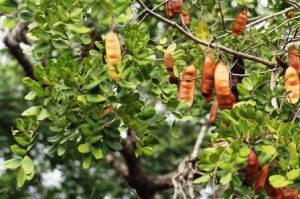
Erythrophleum africanum. Photo: Bart Wursten. Source: Flora of Zimbabwe
Three other typical species which we did not see, although we looked at these quite recently, are: Baikiaea plurijuga (Zambezi teak), Erythrophleum africanum (Ordeal tree) and Peltophorum africanum (African wattle).
In the subfamily, Mimosoideae, we looked at Acacia erioloba (Camel thorn), with its curved, broad, furry pods. The subfamily, Papilionoideae has a very characteristic Kalahari sand species, namely Baphia massaiensis subsp. obovata (Jasmine pea), which has white pea flowers and simple leaves with a swollen petiole.
In the family Burseraceae, the Sand commiphora, Commiphora angolensis is confined to Kalahari sand. It is a shrub or small tree with 3-foliolate leaves.
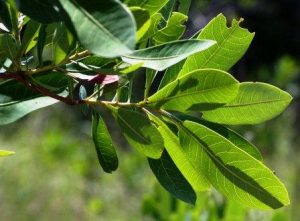
Terminalia brachystemma. Photo: Bart Wursten. Source: Flora of Zimbabwe
In the Combretaceae, we saw Terminalia brachystemma, a species close to Terminalia sericea, but differing in the glabrous leaves which lack silvery hairs and in the usual absence of a petiole. Combretum apiculatum, as Tom has often told us, occurs everywhere in the lowveld and may occur on the edges of dry forest. It has a lemon-yellow slash. Similarly, Combretum zeyheri may occur but is obviously in many other associations too.
Another characteristic tree of Kalahari sand is Schinziophyton rautanenii (Manketti tree) in the Euphorbiaceae.
A further point is that geological maps show areas near Mvuma (e.g. the Mtao Forest area) as Kalahari sand, but while this appears to have very few of the typical Kalahari sand species, such as Grewia retinervis, (seen by the Society there on the way down to Beitbridge in January), it lacks the typical assemblage of Baikiaea, Baphia, Paropsia, Erythrophleum etc. The general feeling was that it was too isolated from the main block and perhaps also the rainfall was too high.
Thanks very much to Tom for his expert guidance. We shall continue on this subject next month.
-MAHyde
JESSE – PART 2
At the walk on Saturday May 5, 2001, Tom continued with species of the jesse. The morning was beautiful with blue skies and a warm temperature and we got more members than recently, about 20.
A species we looked at last time was Combretum celastroides (Jesse-bush combretum). However, not enough emphasis was given to in the previous write-up. It is a key species, like Meiostemon, and occurs in all the different types of jesse. Features not noted last time are the greyish-white stems, the persistent style at the apex of the fruit and the colours the leaves produce in autumn.
Another species from the family is Combretum apiculatum (Red bushwillow) but this abundant lowveld species is only a marginal one in jesse.
A number of legume species were then seen. In the subfamily Mimosoideae, the species Acacia tortilis subsp. spirocarpa (Umbrella thorn) occurs from time to time in the jesse. It is usually flat-topped.
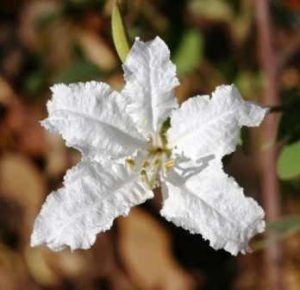
Bauhinia petersiana subsp. macrantha. Photo: Bart Wursten. Source: Flora of Zimbabwe
In the Caesalpinioideae, another frequent species in jesse is Bauhinia petersiana subsp. macrantha. This is also a characteristic species of Kalahari Sand is and is dealt with there. The species, Guibourtia conjugata (Small false mopane), occurs in jesse on both the lower and upper wankie sandstone in the Hwange / Binga area but is absent from jesse in the rest of the Zambezi valley.
In the subfamily Papilionoideae, Philenoptera bussei (better known as Lonchocarpus bussei) (Narrow lance-pod) occurs in jesse. It has the typical features of the genus with opposite leaflets and a larger (slightly) terminal leaflet. Another species of the subfamily is Xeroderris stuhlmannii (Wing pod). This species is not confined to jesse and is frequent in other associations as well. Indeed, like Combretum apiculatum, this is a marginal jesse species.
Another very characteristic jesse species is Dalbergia martinii (Zambezi dalbergia). This has a small number of leaflets arranged in an alternate or subopposite manner. The most striking feature was well illustrated by the plant in the Gardens, namely the flat pods with sticky patches on their faces. The stickiness was extraordinarily persistent on my fingers and also possessed a reasonably nice smell.
Turning to the Rubiaceae, it was perhaps a little surprising to discover that the very common Vangueria infausta (Wild medlar) is also a usual component of jesse.
In Oleaceae, Schrebera trichoclada (Wooden pear), although not solely jesse, strays in to it and is quite typical. This species has opposite leaves and looks generally like a Combretum. Various ideas were suggested as to how to separate it (in the absence of flowers or fruits which would make it easy). These included the pale, prominent veins beneath (Maureen) and the presence of lenticels (Meg). Tom said that he named it by elimination – no Combretum fits!
Two other marginal jesse species seen were the Baobab and the Marula, Sclerocarya birrea.
We also looked at the jesse species recorded from Tashinga (nr Matusadona). Tom explained that this is an unusual form of jesse and contains some unusual species not seen elsewhere. As these are not really typical, I have not dealt with them in detail here.
Once again, thanks to Tom for an illuminating walk.
-MAHyde
KIRKIA
Kirkia, published by the National Herbarium and Botanic Garden in Harare, is the journal of botany in Zimbabwe that was started in 1960 by Hiram Wild. Now in its 18th volume (each volume consists of two parts), a part comes out approximately every year. The present editors are Shakkie Kativu and Jonathan Timberlake.
The journal accepts scientific papers on all aspects of botany from the Flora Zambesiaca region (Botswana, Malawi, Mozambique, Zambia, Zimbabwe) and further afield, and is particularly strong on plant taxonomy, checklists and plant ecology from this area.
For bird records or observations of interesting bird behaviour, the journal Honeyguide of the Ornithological Association of Zimbabwe (now BirdLife Zimbabwe) provides an excellent means of documentation, and there are similar ornithological journals or newsletters in other southern African countries. But a similar vehicle for botanical records or short notes is not available here, a gap that we, the editors of Kirkia, would like to fill. We are now intending to publish short notes on new records, significant range extensions of species, or brief notes on ecology or conservation status of plants. Not just for Zimbabwe but also for the region.
The editors would welcome any contribution from members of the Tree Society or other non-professional botanists. Please don’t feel put off by the “scientific” nature of the journal. Notes can be very brief (half a page or more), but should include: a title, authors’ name and address, and a clear indication of the species being referred to. New records should have a grid reference and ideally a specimen citation or confirmation of identity. Either of the editors can assist contributors with content and presentation if required. Articles, notes or records should initially be sent to: The Editor, Kirkia, National Herbarium, P.O. Box CY 550 Causeway, Harare.
We look forward to further Tree Society involvement in the documentation of Zimbabwe’s botanical heritage.
BUSHMAN ROCK: 17 JUNE, 2001
The sun shone brightly from a true blue winter sky when we visited the dynamic farm of Rick and Sally Passaportis in the Ruwa/ Melfort area. The effects of the horrendous fuel price hike were evident in the reduced number of members present.
As we enjoyed coffee on the veranda we gazed over several large vineyards and a fair-sized dam built on the Nyamasanga river, a most attractive view with surrounds of granite kopjes. The family cats and dogs were so friendly to every one and on the lawn were a small group of white faced duck who chattered incessantly. The duck are kept on the lawn and away from the dam a s a wicked leguaan lurks on the grassy banks.
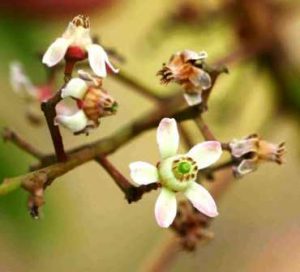
Ekebergia benguelensis. Photo: Bart Wursten. Source: Flora of Zimbabwe
Our walk was through typical miombo woodland with an interesting variety of species. Rick was very eager to learn the names of the tress and came well prepared with marker pen and tags and as Mark identified each tree/ shrub they were methodically numbered, tagged and recorded on his field card. As we wandered on we came to a large wetland area where the water was still draining strongly from the heavy rains that Bushman Rock Farm had received during the past season; here Syzygium cordatum, Tarenna neurophylla and an Erythrina lysistemon flourished. Protea angolensis and welwitschii were prevalent in the woodland and Ekebergia benguelensis were most attractive with their autumn-coloured leaves.
On our return we relaxed on the veranda and enjoyed our picnic lunches with Rick kindly providing wine from their own grapes which was enjoyed. Sally had attended a course on viniculture and wine making in the Cape Province where she was well received, encouraged and helped in many ways by the experts. Our tour around the winery was most interesting and informative with huge vats quietly maturing the various blends of wine.
Thank you Rick and Sally for a lovely day spent on your farm.
Meg Childes
NOTES FROM THE LAY-BYS
A recent holiday in South Africa, from mid-April to the end of May, was not very rewarding from a botanical point of view, but it was not devoid of botanical interest.
The latter part of April in the eastern Free State puts one very firmly in autumn, and many of the exotic trees that have been planted on farms and along urban streets were in the process of changing colour. Some of them were quite spectacular, with various shades of yellow, red, brown, and much in between. Among the species we saw in their autumn glory were Betula alba (European birch), Quercus robur(European oak), Q. palustris(pin oak), Liquidambar styraciflua(sweetgum), Fraxinus americana (white ash), Robinia pseudoacacia(black locust), Ceratonia siliqua (honey locust), Salix babylonica(weeping willow), Populus deltoides (cottonwood), P. nigra `Italica’ (Lombardy poplar), and Taxodium distichum (baldcypress, or swamp cypress).
From the Free State Anne and I travelled down to the Cape, specifically to Wellington, and we stopped for a night at an excellent B&B at Three Sisters in the karroo. Here we came across a specimen of Acacia karroo (sweet thorn) with quite the longest-and sharpest-thorns I have ever seen on any acacia. I brought back specimens up to 15 cm long-some thorns!
The fynbos was right out of season, and only the odd specimen of Erica showed any signs of a flower, but there was a yellow-flowering subshrub (unidentified) that occurred quite commonly. We visited the little village of Darling, just off the west coast, to see an old friend who is currently one of the leading lights looking after a wild-flower nature reserve. It was not the season for any of the flowers, but on the pavement outside the house was an enormous specimen of what I think was Rhus pendulina. At first sight it looked rather like a willow, and certainly had very pendulous leaves-not as long as those of the well-known R. lancea, and I did not recognize the tree as this latter species, but I could have been wrong. The tree was all of 8 metres tall, and had a bole diameter of about 70 cm.
The 15-20-km stretch of country between Darling and the coastal town of Ysterfontein (also known as Yzerfontein) is almost a disaster area of rampant invasion by one of the Australian acacias, possibly the Port Jackson `willow’, Acacia saligna, but some people I spoke to thought it was one of the other phyllodinous Australian acacias, either A. cyclops(red eye) or A. longifolia (sallow wattle). Since the three are known to be present in that general region, what we saw could have been a mixture of all of them. As an aside, Ysterfontein or Yzerfontein both mean `iron spring’; the first name is Afrikaans and the second is Dutch, and both are official. This place is mostly given over to holiday homes for keen sea anglers. There is a beautiful beach, but I doubt whether any self-respecting person would want to swim in the very cold water of the west coast. The Beaches Restaurant in Ysterfontein serves magnificent seafood meals, and Anne and I-and my sister, who was with us-lunched sumptuously!
After two weeks at Wellington we travelled up the Garden Route to our favourite haunt, Kenton-on-Sea, about halfway between Port Elizabeth and East London, stopping overnight at a B&B at Storms River. This was adequate, but nothing to write home about. Kenton was its usual, beautiful self, and there we were treated to our first sight of the tree aloe, Aloe barberae, in full flower. Some specimens at Kenton are very large-up to 12 metres or more in height and a metre or more in diameter at the base. The largest of them have a known planting date of 1954, so they are fairly fast growing. In the Eastern Cape, generally, Aloe ferox(bitter aloe) was everywhere in full flower, particularly along the road between Grahamstown and Queenstown, where this species was often the dominant plant over large areas.
The sea was too cold for enjoyable swimming at Kenton, in spite of the glorious mid-May weather, and the moon was wrong for really low tides, so our exploration of the marine life in the magnificent rock pools was severely curtailed. Nevertheless, it is a wonderful place for switching off and letting the world go by, especially during our current situation in Zimbabwe.
Lesotho Excursion
After two weeks at Kenton it was back to the Free State, and a trip into the Lesotho mountains to see something of the Lesotho Highlands Water Project. We visited the Katse Dam, the first of the planned five or six dams of the whole project. This is 150 km (and a good 2-hour drive) from Ficksburg in the Free State. The road over the mountains is a magnificent feat of engineering, and was designed to cope with a 35-tonne truckload of cement or other materials every 45 minutes, day and night, winter or summer, in rain or snow or ice, every day of the year while the dam was under construction. The road was mostly cut out of solid rock, but there are two places where a retaining wall of concrete had to be built up to take the road surface. Gradients are steep-not for the faint-hearted- and the highest altitude reached is 3090 m (10 138 feet). There was a dusting of snow when we were there, and a great deal of ice in the road drains. The road traverses two ranges of mountains, and then back over the second range-a deviation that became necessary when the local Sotho chief refused to give permission for a route through his territory unless his own village was included in the alignment.
The Katse Dam is 185 m high, and has a maximum depth of water of 180 m. Some kilometres upstream of the wall is a water take-off point 90 m below the surface, and this leads water through a 40-km tunnel (something like 8 m in diameter) through the mountains to Clarens in the Free State, where it spills out into the Vaal River system, and eventually into the Vaal Dam, the chief source of water for the Gauteng area. Katse village was built to house the people working on the dam, and among the facilities now being developed in the village is an alpine botanical garden. The paths have been laid out on the hill slope, the site is completely enclosed in a security fence, and a nursery has been established. The place was closed for a public holiday on the day we visited, but we were allowed in for a picnic lunch thanks to the persuasiveness of our Free State friends, who speak Sesotho fluently.
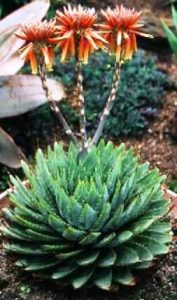
Aloe polyphylla. Source: PlantzAfrica
It was in this nursery that we saw the spiral aloe, Aloe polyphylla, a Lesotho Highlands endemic. This plant produces “up to 150 leaves from the base, always arranged in 5 rows of 15-30 leaves with a clockwise or counter-clockwise twist” (description from Reynolds). None of the plants we saw had anywhere near 150 leaves, but their arrangement was quite fascinating. There were many other alpine plants in the nursery that we are familiar with in our own Eastern Highlands, but I did not record their names. In time this alpine botanical garden will be well worth a visit, and there is a lodge in Katse village for those who might want to stay overnight.
A Railway Sleeper Plantation
Just outside Ficksburg there is a flat-topped mountain named Imperani, on which the Railway Sleeper Plantation Company decided to establish plantations of various species for the production of railway sleepers. This was shortly after the Anglo-Boer War. The species selected were those that had been used for railway sleepers in their countries of origin, and on a visit to the site with our farmer friend, who is writing a history of the Ficksburg district, I was able to identify eight species. These were Cedrus deodara(deodar), Pinus canariensis(Canary Island pine), P. pinaster (cluster pine, or maritime pine), P. montezumae (Montezuma pine), P. roxburghii (chir pine), Eucalyptus sideroxylon(red ironbark), E. viminalis(manna gum), and Acacia mearnsii(black wattle). The project never came to anything because the proponents had miscalculated the growth rates of the species on this particular site, but the trees stand there to this day, largely unused except by gatherers of the odd bit of fuelwood. Nevertheless, very many of the trees have now reached a respectable size, and could be put to good use in a one-off harvesting exercise.
A Word of Warning
Anne and I were horrified to find that in spite of having multiple entry visas for South Africa, each entry was limited to 30 days. We had planned to be in the country for 46 days, and this was stated on the visa application. We also had proof of our ability to support ourselves for the whole period. There was nothing we could do except to apply for extensions to our visas. This we did in Paarl, and had the formalities completed in Grahamstown, but it cost us R390 each for the extensions-all unbudgeted, of course! So, anyone contemplating a visit of more than 30 days to South Africa should take note of this. The visa will cost you nothing, but you will have to pay anything from ZW$3000 to ZW8000 for the extension, depending on whether you sourced your forex on the official market, the parallel market, or the black market!
-Lyn Mullin
In Retrospect – Lyn Mullin AUSTRALIAN CHESTNUT
What we call Australian chestnut is more commonly known in Australia as black bean or Moreton Bay chestnut. The species is Castanospermum australe(Papilionoideae), and it came up for discussion during the Botanic Garden walk in January 1990, reported in TREE LIFE No.120 (February 1990), when Kim Damstra wrote:
This is one of those trees that I had not noticed before last month, and now find that they are very common indeed. I obviously walk around with my eyes closed sometimes. It is a legume with swollen pods and large seeds, which are poisonous when raw, but the black beans roasted are edible. Apparently it has been suggested that compounds from this tree may help to suppress the AIDS virus, but this has not been confirmed. The first specimen was brought to Southern Rhodesia by Andre Holland’s grandfather, and grows on the corner of North and Chancellor Avenues on the Prime Minister’s property. It used to have a plaque on it.
[Comment 2000: This species makes a very fine shade tree in Zimbabwe, and is unusual in that the racemes of yellow- to orange-coloured flowers generally arise from the stem (cauline), or are least produced on twigs below the dense crown.In Australia it is a large, rainforest tree up to 40 m tall, with a distribution from northernmost New South Wales to near the top end of the Cape York Peninsula. The wood of black bean is one of Australia’s most attractive cabinet timbers, and is highly prized for carved work, furniture, panelling, plywood, and joinery. Its density is 700 kg/cubic metre (cf red mahogany 590, mukwa 640, and Zambezi teak 815). The seeds are poisonous to eat unless first sliced and washed in water for several days to remove the saponin.]
While on holiday to the UK recently Maureen spent a wonderful day in Kew Gardens with Fiona Dawe. Fiona and Pat remember their Tree Society outings with great joy and send best wishes to everyone.
Please write or e-mail us with any observations you made during the recent amazing solar eclipse with regard to animal, bird or plant behaviour. Other members will be interested in sharing your experiences through Tree Life.
For Harare there have been some changes to the office bearers. After several years in the chair Andy has resigned and we welcome and thank Joan and Eva for offering their services on the committee.
MARK HYDE CHAIRMAN


